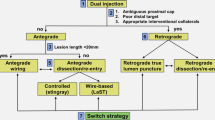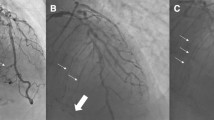Abstract
Objective
Percutaneous treatment of coronary chronic total occlusions (CTO) remains one of the major challenges in interventional cardiology. The strategies of recanalisation in CTO have changed drastically due the development of new techniques such as the retrograde approach via collaterals. In this single-centre experience we sought to analyse the success rates with the use of different CTO techniques, the complication rates, and we evaluated predictors of failed CTO recanalisation attempts.
Methods and Results
In this single-centre observational study we analysed the prospectively entered data of 331 consecutive patients, undergoing percutaneous coronary intervention (PCI) for CTO in 338 lesions at the Heart Center Wuppertal between June 2007 and July 2010. Nineteen lesions were attempted twice and one lesion three times (=358 procedures). The lesion-related success rates were 81.1%. Single-wire usage was the predominant strategy used in 198 antegrade cases (65.6%) followed by parallel wire technique and see-saw technique in 94 cases (31.1%). In the retrograde procedures, the reverse CART technique was predominantly used (35.7%), followed by retrograde wire passage (17.9%), marker wire (17.9%) and CART (14.3%). The in-hospital complications were low and comparable with conventional PCI data. The presence of blunt stump, severe calcification, severe tortuosity and occlusion length >30 mm were independent predictors of procedural failure.
Conclusions
A high degree of success with low in-hospital complications comparable with conventional PCI data can be expected in the hands of experienced CTO operators. A second try with a retrograde approach after antegrade failure should be considered.

Similar content being viewed by others
References
Di Mario C, Werner GS, Sianos G, et al. European perspective in the recanalization of Chronic Total Occlusions (CTO): consensus document from the EuroCTO Club. EuroIntervention. 2007;3:30–43.
Puma JA, Sketch MH, Tscheng JE, et al. Percutaneous revascularization of chronic coronary occlusions: an overview. J Am Coll Cardiol. 1995;26:1–11.
Sirnes PA, Golf S, Myreng Y, et al. Stenting in Chronic Coronary Occlusion (SICCO): a randomized, controlled trial of adding stent implantation after successful angioplasty. J Am Coll Cardiol. 1996;28:1444–51.
Simes PA, Myreng Y, Molstad P, et al. Improvement in left ventricular ejection fraction and wall motion after successful recanalization of chronic coronary occlusions. Eur Heart J. 1998;19:273–81.
Dzavik V, Carere RG, Mancini GB, et al. Predictors of improvement in left ventricular function after percutaneous revascularization of occluded coronary arteries: a report from the Total Occlusion Study of Canada (TOSCA). Am Heart J. 2001;142:301–8.
Olivari Z, Rubartelli P, Piscione F, et al. Immediate results and one year clinical outcome after percutaneous coronary interventions in chronic total occlusions: data from a multicenter, prospective, observational study (TOAST-GISE). J Am Coll Cardiol. 2003;41:1672–8.
Hoye A, van Domburg RT, Sonnenschein K, et al. Percutaneous coronary intervention for chronic total occlusions: the Thoraxcenter experience 1992–2002. Eur Heart J. 2005;26:2630–6.
Nakamura S, Muthusami TS, Bae JH, et al. Impact of sirolimus eluting stent on the outcome of patients with chronic total occlusions. Am J Cardiol. 2005;95:161–6.
Suero JA, Marso SP, Jones PG, et al. Procedural outcomes and long term survival among patients undergoing percutaneous coronary intervention of a chronic total occlusion in native coronary arteries: a 20-year experience. J Am Coll Cardiol. 2001;38:409–14.
Hannan EL, Racz M, Holmes DR, et al. Impact of completeness of percutaneous coronary intervention revascularization on long-term outcomes in the stent era. Circulation. 2006;113:2406–12.
Safley DM, House JA, Marso SP, et al. Improvement in survival following successful percutaneous coronary intervention of coronary chronic total occlusions: variability by target vessel. J Am Coll Cardiol Intv. 2008;1:295–302.
Valenti R, Migliorini A, Signorini U, et al. Impact of complete revascularization with percutaneous coronary intervention on survival in patients with at least one chronic total occlusion. Eur Heart J. 2008;29:2336–42.
Kimura M, Katoh O, Tsuchikane E, et al. The Efficacy of a bilateral approach for treating lesions with chronic total occlusions. The CART (Controlled Antegrade and Retrograde subintimal Tracking) registry. J Am Coll Cardiol Intv. 2009;2:1135–41.
Ochiai M. Retrograde approach for total occlusion: present status and prospects. EuriInterv. 2007;3:169–73.
Sianos G, Barlis P, Di Mario C, et al. European experience with the retrograde approach for the recanalisation of coronary artery chronic total occlusions. A report on behalf of the EuroCTO Club. EuroInterv. 2008;4:84–92.
Matsubara T, Murata A, Kanyama H, et al. IVUS-guided wiring technique: promising approach for the chronic total occlusion. Catheter Cardiovasc Interv. 2004;61:381–6.
Hirokami M, Saito S, Muto H. Anchoring technique to improve guiding catheter support in coronary angioplasty of chronic total occlusions. Catheter Cardiovasc Interv. 2006;67:366–71.
Mamas MA, Fath-Ordoubadi F, Fraser D. Successful use of the Heartrail III Catheter as a stent delivery catheter following failure of conventional techniques. Catheter Cardiovasc Interv. 2008;71:358–63.
Reifart N, Enayat D, Giokoglu K. A novel penetration catheter (Tornus) as bail-out device after balloon failure to recanalise long, old calcified chronic occlusions. EuroInterv. 2008;3:617–21.
Saito S. Different strategies of retrograde approach in coronary angioplasty for chronic total occlusion. Catheter Cardiovasc Interv. 2008;3:165–71.
Surmely JF, Tsuchikane E, Katoh O, et al. New concept for CTO recanalization using controlled antegrade and retrograde subintimal tracking: the CART Technique. J Invasive Cardiol. 2006;18:334–38.
Rathore S, Katoh O, Tsuchikane E, et al. A novel modification of the retrograde approach for the recanalization of chronic total occlusion of the coronary arteries. Intravascular ultrasound-guided Reverse Controlled Antegrade and Retrograde Tracking. J Am Coll Cardiol Intv. 2010;3:155–64.
Abbott JD, Kip KE, Vlachos HA, et al. Recent trends in the percutaneous treatment of chronic total coronary occlusions. Am J Cardiol. 2006;97:1691–6.
Prasad A, Rihal CS, Lennon RJ, et al. Trends in outcomes after percutaneous coronary intervention for chronic total occlusions: a 25-year experience from the Mayo Clinic. J Am Coll Cardiol. 2007;49:1611–8.
Hoye A, van Domburg RT, Sonnenschein K, et al. Percutaneous coronary intervention for chronic total occlusions: the Thoraxcenter experience 1992–2002. Eur Heart J. 2005;26:2630–6.
Werner GS, Hochadel M, Zeymer U, et al. Contemporary success and complication rates of percutaneous coronary intervention for chronic total coronary occlusions: results from the ALKK quality control registry of 2006. EuroInterv. 2010;6:361–6.
Rathore S, Matsuo H, Terashima M, et al. Procedural and In-hospital outcomes after percutaneous coronary intervention for chronic total occlusions of coronary arteries 2002 to 2008. J Am Coll Cardiol Intv. 2009;2:489–97.
Thompson C, Jayne JE, Robb JF, et al. Retrograde techniques and the impact of operator volume on percutaneous intervention for coronary chronic total occlusions an early U.S. experience. JACC Cardiovasc Intv. 2009;2:834–42.
Yang EH, Gumina RJ, Lenon RJ, et al. Emergency coronary artery bypass surgery for percutaneous coronary intervention: changes in the incidence, clinical characteristics, and indications from 1979 to 2003. J Am Coll Cardoiol. 2005;46:2004–9.
Grayson AD, Moore RK, Jackson M, et al. on behalf of North West Quality Improvement Programme in Cardiac Interventions. Multivariate prediction of major adverse cardiac events after 9914 percutaneous coronary interventions in the north west of England. Heart. 2006;92:658–63.
Author information
Authors and Affiliations
Corresponding author
Rights and permissions
About this article
Cite this article
Bufe, A., Haltern, G., Dinh, W. et al. Recanalisation of coronary chronic total occlusions with new techniques including the retrograde approach via collaterals. Neth Heart J 19, 162–167 (2011). https://doi.org/10.1007/s12471-011-0091-7
Published:
Issue Date:
DOI: https://doi.org/10.1007/s12471-011-0091-7




